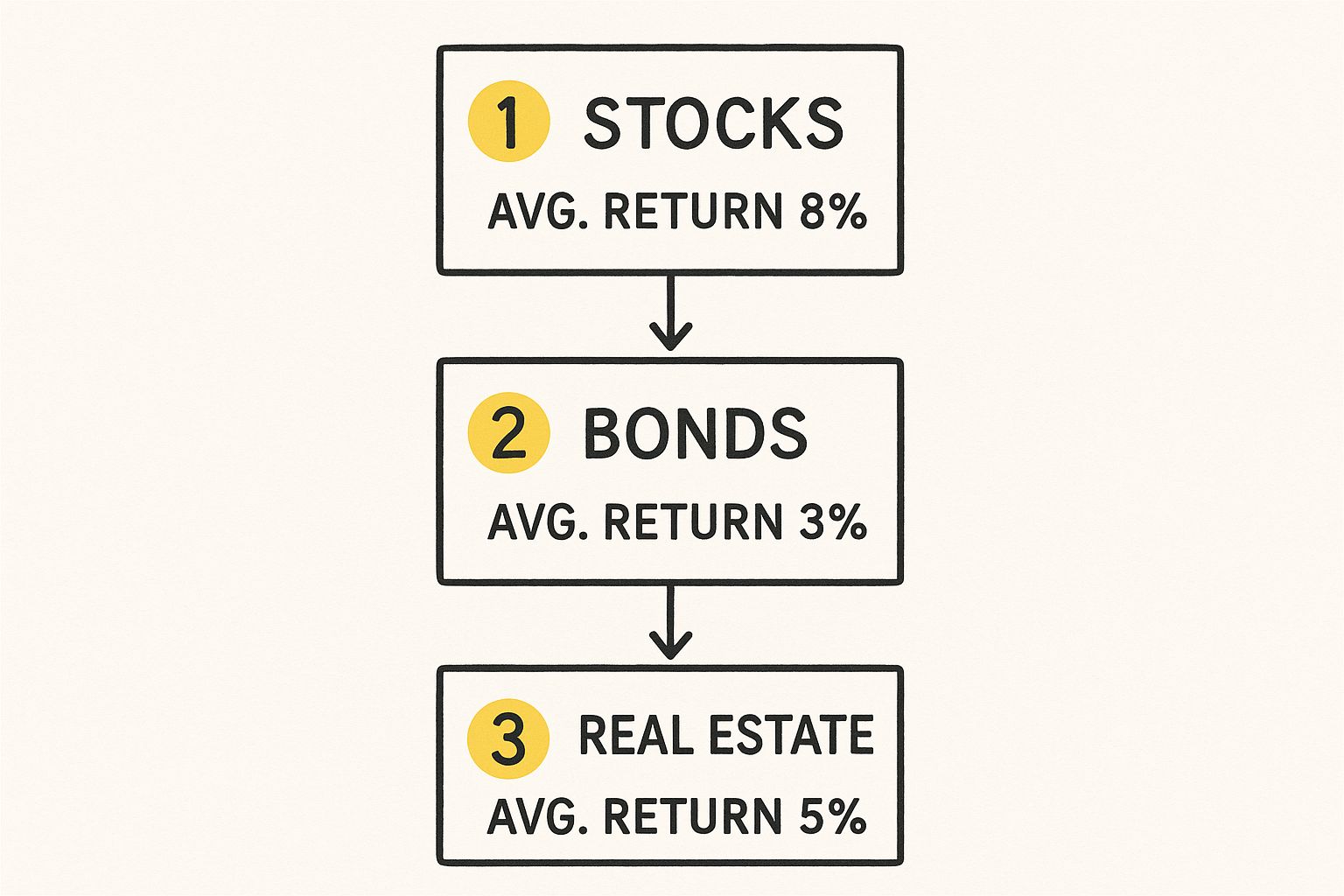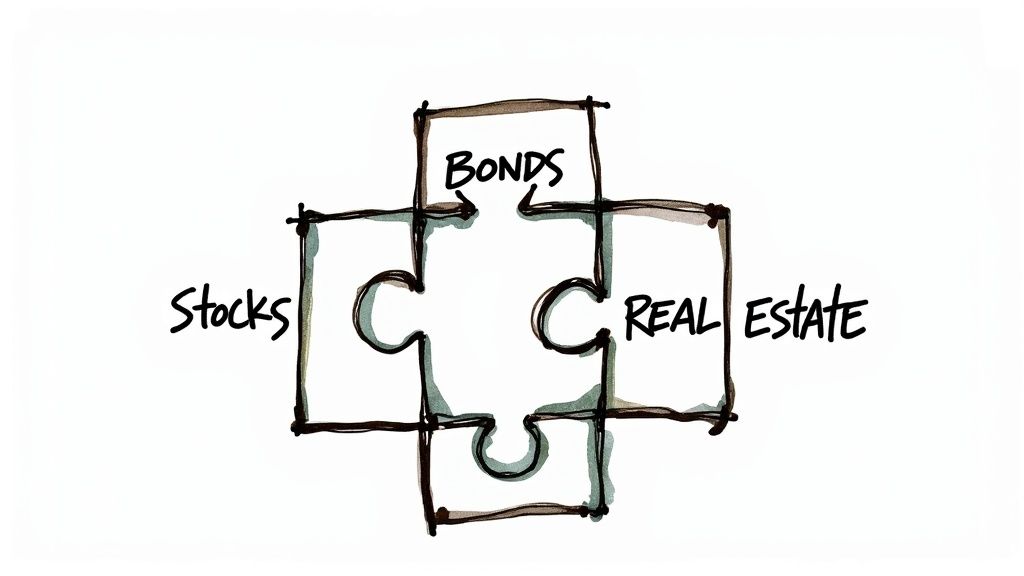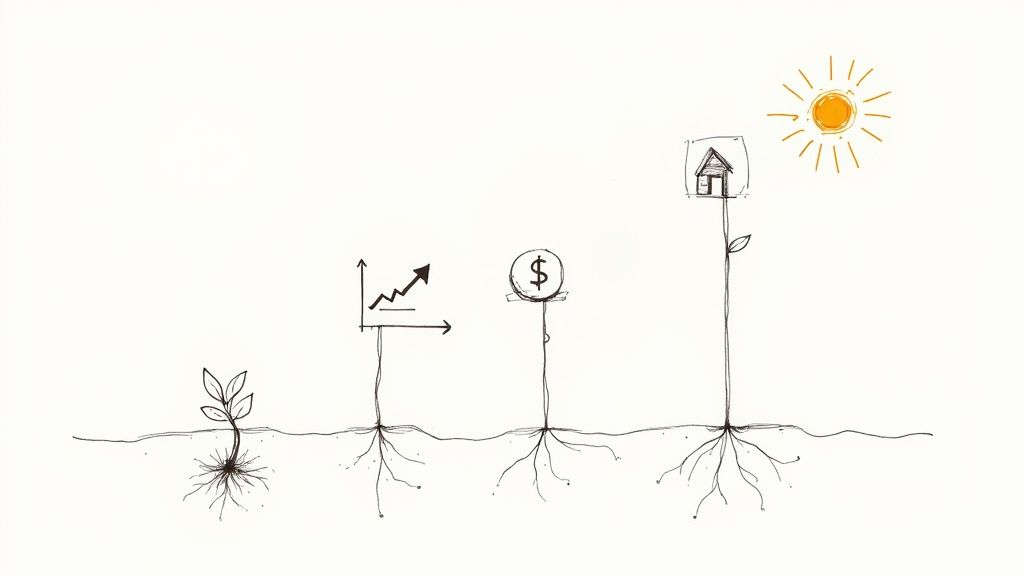Putting your money to work through investing is the most reliable way to build serious wealth over the long haul. It's the difference between letting your cash sit idly by, slowly losing value, and actively growing it into something substantial. This investing for beginners guide is your roadmap to starting that journey with confidence.
In This Guide
- 1 Why Investing Is the Engine for Your Financial Goals
- 2 Getting to Know Your Investment Options
- 3 Thinking Globally: How to Invest Beyond Your Borders
- 4 A Practical Guide to Making Your First Investment
- 5 Building a Portfolio That Lets You Sleep at Night
- 6 Common Investing Mistakes and How to Avoid Them
- 7 Frequently Asked Questions (FAQ)
Why Investing Is the Engine for Your Financial Goals

Think of a savings account like a secure parking garage for your money. It’s safe, but it's not actually going anywhere. In fact, thanks to inflation, the purchasing power of that parked cash is silently eroding year after year.
Investing, on the other hand, is like getting that money on the highway and hitting the accelerator. It’s the engine that powers you toward your biggest life goals—whether that’s buying a house, paying for your kids' college, or enjoying a comfortable retirement.
The secret sauce that makes investing so incredibly powerful is compounding. It's like planting a tiny money tree. At first, it's just your initial investment. But soon, it starts to produce returns—think of these as new branches. Before you know it, those branches start sprouting their own branches, and the growth just keeps accelerating. This is the magic of compounding: your earnings start generating their own earnings.
The Power of Starting Early: A Real-Life Example
Let’s see how this plays out in the real world with two friends, Alex and Ben, who are both saving for retirement.
- Alex starts investing at age 25. She puts away just $200 a month into an investment account that averages an 8% annual return. She does this for only 10 years and then stops adding new money, simply letting her investment grow.
- Ben waits until he's 35 to start. He also invests $200 a month at the same 8% return, but he invests consistently for 30 years, all the way to age 65.
The results are astonishing. By age 65, Alex, who only invested a total of $24,000, would have a nest egg worth roughly $315,000. Ben, despite investing a total of $72,000 over three decades, would only have about $272,000.
That extra decade gave Alex’s money a massive head start to compound, completely changing the outcome. It's a powerful lesson we dive into deeper in our article on the magic of compound interest explained.
The single most important factor in your investment success isn't how much you start with—it's how much time you give your money to grow. Waiting to invest is the biggest financial mistake most people make.
This simple example proves a crucial point: investing isn't just for the rich. It's the primary tool for anyone looking to build wealth. By shifting your mindset from just saving cash to actively making your money work for you, you can completely transform your financial future.
Getting to Know Your Investment Options
Jumping into investing can feel like walking into a conversation where everyone's speaking a different language. You’ll hear words like "equities," "fixed income," and "asset classes" tossed around, and it's easy to feel lost. Let's break down what these things actually are, using simple terms.
Think of this as your quick-start guide. Once you know what you’re buying and why, you'll feel much more confident about where your money is going.
Stocks: Owning a Slice of the Pie
The first and most famous type of investment is a stock, which is also called an equity.
Buying a stock is like buying a tiny piece of a company. Imagine your favorite local pizza shop decided to sell small slices of ownership to the public. If you bought one, you'd officially be a part-owner.
When the business does well, your slice becomes more valuable. If things go really well, the shop might even share some of its profits with you, which is called a dividend. The main reason people buy stocks is for growth—the potential for their investment to be worth a lot more down the road.
Bonds: The Professional IOU
Next up, we have bonds, which work in a completely different way.
When you buy a bond, you're essentially lending money to a government or a big corporation. They promise to pay you back the full amount on a set date, and in the meantime, they give you regular interest payments for the trouble. It's just a formal IOU that pays you to wait.
Because they're so predictable, bonds are perfect for bringing stability and income to your investment mix. They often zig when the stock market zags, which helps balance things out. The market is always moving, and you can learn more about understanding stock market cycles for better investing to get a feel for how different assets behave over time.
ETFs: The All-in-One Basket
Finally, there are Exchange-Traded Funds, or ETFs. These are a game-changer for new investors.
Think about making a fruit salad. You could go to the store and painstakingly pick out every single apple, banana, and handful of grapes yourself. Or, you could just grab a pre-made fruit salad basket that has a great mix already in it. An ETF is that basket.
An ETF bundles together hundreds—sometimes thousands—of different stocks or bonds into one simple product you can buy. For instance, an S&P 500 ETF lets you own a tiny piece of the 500 largest companies in America with a single click. This is the easiest way to achieve instant diversification, which is just a fancy word for not putting all your eggs in one basket.
Comparison: Stocks vs. Bonds vs. ETFs for Beginners
Seeing them side-by-side really helps clarify the unique job each one has. Here’s a simple breakdown of how these three core investment types stack up.
| Asset Type | What It Is in Simple Terms | Primary Role in a Portfolio | General Risk Level |
|---|---|---|---|
| Stocks | A small piece of ownership in a single company. | Growth of your initial investment over the long term. | Higher |
| Bonds | A loan made to a company or government for interest payments. | Stability and predictable income. | Lower |
| ETFs | A basket containing many different stocks or bonds. | Instant Diversification and easy access to the market. | Varies (Medium) |
By understanding these three pillars—stocks for growth, bonds for stability, and ETFs for diversification—you've already cracked the code. This is the foundation every smart investment plan is built on.
Thinking Globally: How to Invest Beyond Your Borders

When people first start investing, it's natural to stick with what you know—the big-name companies in your own country. While that feels safe, this "home country bias" can accidentally hold back your portfolio and leave it vulnerable. A truly robust investment strategy needs to look beyond its own backyard.
Think of it this way: if your entire financial future depended on the economy of a single town, you'd be in big trouble if that town hit a rough patch. Investing internationally is like owning businesses in dozens of different towns. A slump in one doesn't spell disaster for your entire portfolio.
Why a Global View Matters
Economic growth isn't uniform. Different countries hit their stride at different times. While one market is crawling along, another might be sprinting ahead. By investing globally, you're positioning yourself to catch that growth, wherever it happens to pop up.
For example, there have been long stretches where the U.S. stock market was flat, while emerging markets in Asia or South America were delivering incredible returns. This kind of global diversification acts like a shock absorber for your portfolio, smoothing out the inevitable bumps along the way.
The point of international investing isn't just about chasing the next hot market. It's about building a more resilient, stable portfolio that doesn't live or die by the economic health of a single nation.
Lately, the performance gap between U.S. and international stocks makes this strategy even more compelling. Non-U.S. markets, like Mexico and Brazil, have shown real strength thanks to improving economic conditions and more attractive prices. This provides a compelling alternative to a U.S. market that has sometimes felt overvalued. For anyone looking for growth, a globally balanced portfolio can open up a world of new opportunities. To dig deeper into this trend, you can discover more insights on why this is a good year to invest in international stocks on morningstar.com.
Making Global Investing Simple
The thought of analyzing foreign companies and economies sounds daunting, right? The good news is, you don’t have to be a geopolitics expert to get started. Modern investment tools have made it surprisingly easy.
The simplest on-ramp for global investing is through international ETFs and mutual funds. These work just like the funds we’ve already talked about, but instead of holding a basket of domestic stocks, they hold shares in companies from all over the world.
Here’s a quick comparison of your main options for international exposure:
| Fund Type | What It Is | Best For Beginners? | Example |
|---|---|---|---|
| Total International Stock ETF | A single fund that invests in thousands of companies across all developed and emerging markets outside your home country. | Yes. This is the ultimate "one-stop shop" for instant global diversification. | Vanguard Total International Stock ETF (VXUS) |
| Regional ETF | A fund that zooms in on one part of the world, like Europe or Asia. | Better for experienced investors, as it requires betting on a specific region's success. | iShares MSCI EMU ETF (EZU) for Europe |
| Country-Specific ETF | A fund focused on a single country, like Japan or Brazil. | Advanced. Best for targeted strategies, not core holdings. | iShares MSCI Japan ETF (EWJ) |
For anyone just starting out, a total international stock ETF is usually the perfect fit. In one transaction, you become a part-owner of thousands of companies across Europe, Asia, Australia, and other regions. You get that crucial geographic diversification without ever having to research a single foreign company. This is similar to the approach used by the world's largest investors, which we explore in our guide on what sovereign wealth funds are and why they matter.
A Practical Guide to Making Your First Investment
Alright, this is where the rubber meets the road. We’ve covered the "why" and the "what," but confidence really comes from doing. So, let's walk through the exact steps to place your first investment. The goal here is to make this process feel less like a complex financial transaction and more like signing up for a new app on your phone.
Step 1: Choose the Right Investment Account
Before you can buy a single stock or fund, your money needs a home—a place where it can sit and grow. This home is called a brokerage account. Think of it as a special kind of bank account just for your investments. For most beginners, there are two main types to consider.
-
Standard Brokerage Account: This is your flexible, do-anything investment account. There are no limits on how much you can put in, and you can take your money out whenever you need it. It’s perfect for goals outside of retirement, like saving for a house down payment.
-
Roth IRA (Individual Retirement Account): This one is a specialist, designed specifically for retirement. You put in money you’ve already paid taxes on, and in return, your investments grow 100% tax-free. Even better, when you take the money out in retirement, those withdrawals are also completely tax-free. There are limits to how much you can contribute each year, but the long-term tax savings are incredible.
For a deeper look at the options, our complete guide on how to start investing money can help you get even more clarity.
Comparison: Choosing the Right Investment Account for You
To help you visualize the differences, here’s a quick breakdown of the most common account types. This should make it easier to see which one aligns with your financial goals and timeline.
| Account Type | Primarily Used For | Key Feature | Tax Advantage |
|---|---|---|---|
| Standard Brokerage | General investing, non-retirement goals | Maximum flexibility, no withdrawal restrictions | Capital gains tax on profits |
| Roth IRA | Long-term retirement savings | Tax-free growth and withdrawals | Significant: All qualified withdrawals in retirement are tax-free |
| 401(k) | Employer-sponsored retirement savings | Often includes an employer match (free money!) | Tax-deferred growth; taxes paid on withdrawal |
As you can see, each account is a tool for a specific job. Your 401(k) is fantastic if your employer offers a match, while a Roth IRA provides amazing tax benefits for your personal retirement savings. A standard brokerage account is your go-to for everything else.
Step 2: Select a Beginner-Friendly Platform
Once you’ve decided on the type of account, you need to pick a company to open it with. Decades ago, this meant calling up a stockbroker in a suit. Today, you can do it all from your phone in about 10 minutes. The best platforms for beginners keep things simple, with low fees, an easy-to-navigate app, and good educational content.
Step 3: Fund Your Account and Pick Your First Investment
After you’ve opened your account, it’s time to move some money into it. Just connect it to your regular bank account and transfer some funds. You don’t need a fortune to get started—even $50 or $100 is a great first step.
Now for the big decision: what do you actually buy? For your very first investment, simple is almost always better.
Most beginners will be perfectly served by starting with a low-cost, broadly diversified index fund or ETF. An S&P 500 ETF, for example, lets you instantly own a tiny piece of the 500 largest companies in the U.S.
This single purchase gives you instant diversification, which spreads out your risk. Instead of betting on one company to succeed, you’re betting on the American economy as a whole to grow over time.
This infographic really drives home why stocks are such a foundational part of building wealth.

You can see that stocks, over the long haul, have delivered higher average returns than other major asset classes. That potential for growth is what makes them such a powerful engine for your portfolio.
Step 4: Place Your First Order
You’ve got your account, it has money in it, and you know what you want to buy. The last step is to actually place the order. Inside your brokerage app, you’ll search for the fund’s ticker symbol (for instance, the Vanguard S&P 500 ETF is "VOO"). Then you just type in the dollar amount you want to invest and hit the "buy" button. That’s it. Congratulations—you're officially an investor.
Building a Portfolio That Lets You Sleep at Night

Here's a secret that many new investors miss: successful investing isn't about chasing the latest hot stock or gambling on a long shot. It's about building a solid, sensible plan that matches your goals and lets you rest easy, knowing your money is working for you, not against you.
The first step is a bit of self-reflection. You need to figure out your personal comfort level with the market's inevitable ups and downs. This is what experts call risk tolerance. Are you the "slow and steady wins the race" type? Or are you okay with a bit more of a rollercoaster ride for the chance at higher returns down the road? There’s no right answer here—only the one that’s right for you.
Diversification: The Golden Rule of Investing
Once you have a handle on your risk tolerance, the single most powerful strategy to manage it is diversification. We’ve all heard the old saying, "don't put all your eggs in one basket." In the world of investing, that isn't just a cliché; it's the bedrock of a healthy portfolio.
Think of your portfolio like a basketball team. You wouldn’t want a team of only star shooters, would you? You'd also need solid defenders and rebounders to win games. In investing, stocks are often your shooters (offering high growth potential), while assets like bonds act as your defenders (providing stability when the stock market gets shaky).
A diversified portfolio simply means you're blending different types of assets to smooth out the ride.
- Asset Class Diversification: This is your fundamental mix of stocks and bonds. Historically, when one zigs, the other often zags, which helps balance out your overall returns.
- Geographic Diversification: This means owning investments from various countries. If one country's economy hits a rough patch, your entire portfolio won't sink with it.
This approach is more important than ever in today's global economy. For example, recent outlooks suggest modest growth ahead, with U.S. projections around 2.0% and the Eurozone at 0.9%. While opportunities are still out there, these cautious forecasts show why betting everything on one market is a risky game. Learn more about deeply invested growth strategies on deutschewealth.com.
Smart Strategies for Long-Term Success
Beyond just what you buy, how you buy can make a huge difference. For beginners, one of the most powerful tools is dollar-cost averaging. It sounds technical, but the concept is beautifully simple: you invest a fixed amount of money on a regular schedule—say, $100 every month—no matter what the market is doing.
This disciplined, almost automatic approach takes the emotion and guesswork out of investing. You'll never have to stress about trying to "time the market" perfectly.
When the market is down, your fixed investment buys more shares. When the market is up, it buys fewer. Over time, this averages out your purchase price and dramatically reduces the impact of volatility on your portfolio.
This strategy is all about building good habits. Combine it with a well-diversified portfolio, and you’re creating a strong foundation that can handle market storms. As your investments grow, you’ll also want to check in periodically to make sure everything is still aligned with your goals. Our guide to portfolio rebalancing strategies walks you through how to make those smart adjustments over time.
Common Investing Mistakes and How to Avoid Them
Taking that first step into the world of investing is exciting, but let’s be honest—it usually comes with a huge wave of questions and a bit of uncertainty. In my experience, it’s the practical, "how-do-I-actually-do-this" questions that hold people back, not the complex financial theories. Let's look at common pitfalls and how to steer clear of them.
Real-Life Scenarios: What to Do and What Not to Do
Let's make this even more real. Picture two beginners, Maria and David, who each have $500 to invest. Their different approaches show how mindset and strategy can lead to very different outcomes.
-
Maria's Strategy: The Steady Accumulator
Maria is 28 and wants to get a head start on retirement. She opens a Roth IRA. Instead of trying to pick stocks, she invests her entire $500 into a single, low-cost S&P 500 ETF. She sets up an automatic transfer of $100 every month. When the market dips next quarter, she doesn't panic; her automatic investment simply buys more shares at a lower price. Her focus is on consistent, long-term accumulation. -
David's Strategy: The Emotional Reactor
David, 32, also puts $500 into a brokerage account. He buys a few tech stocks he heard about online. A month later, the market gets volatile and his stocks drop 15%. Worried about losing more, he sells everything. He then misses the market's recovery over the next few months. David let short-term fear dictate a long-term decision.
These scenarios show there’s no single "right" way to start, but there is a wrong way: letting emotion override strategy. The best approach is always the one that fits your personal financial situation and your vision for the future.
Global Investment Flows: A Beginner's Perspective
As you get more comfortable, you might start thinking about opportunities outside of your home country. For beginners, it's helpful to know a little about the global foreign direct investment (FDI) landscape. Recently, FDI has seen some ups and downs thanks to geopolitical tensions and the aftershocks of the pandemic.
But things are looking up. Global FDI flows hit $297 billion in just the first quarter of a recent year and are projected to keep growing. This is a big deal for economies like the U.S., which has been the top destination for FDI for 12 consecutive years. Emerging markets, especially in Asia, are also becoming major players. For a new investor, this means there are opportunities to diversify your portfolio with international funds that tap into this growth. You can learn more about these investment statistics and trends on wisemoneytools.com.
The most important takeaway from any investing for beginners guide is this: action is more important than perfection. You don't need to know everything to start; you just need to start.
Overcoming that initial inertia is the biggest hurdle you'll face. Once you've made your first investment—no matter how small—you've officially put the incredible power of compounding to work for you. From there, it’s all about staying consistent, continuing to learn, and letting time do the heavy lifting.
Frequently Asked Questions (FAQ)
Here are direct answers to the top 10 questions new investors ask, designed to build confidence and clarify common points of confusion.
-
How much money do I actually need to start investing?
You can start with as little as $1. Most modern brokerage apps let you buy "fractional shares," so you can own a piece of a giant company like Apple for just a few dollars. The key is simply to start. -
Is investing the same as gambling?
Absolutely not. Gambling is a short-term bet on a random outcome. Smart investing is a long-term strategy based on owning a piece of the economy's growth. While there is always risk, investing is about calculated ownership, not a roll of the dice. -
What is the safest investment for a total beginner?
While no investment is 100% risk-free, a great starting point for many is a low-cost, broadly diversified index fund or ETF (like an S&P 500 fund). These instantly spread your risk across hundreds of different companies, avoiding the danger of relying on a single stock. -
Do I need a financial advisor to start?
Not necessarily. If you're just starting out with straightforward goals, today's brokerage platforms and robo-advisors make it incredibly easy to get going on your own. You can always bring in a professional later as your portfolio becomes more complex. -
How often should I be checking my investments?
Far less often than you think! For long-term investors, checking your portfolio daily is a recipe for making emotional, knee-jerk decisions. A quarterly or even semi-annual check-in is usually plenty to ensure you're still on track with your goals. -
What happens to my money if the stock market crashes?
A market crash means the value of your investments goes down temporarily. The important thing to remember is that you don't actually lose money unless you sell at that lower price. Historically, markets have always recovered from downturns and gone on to reach new highs. -
What's the difference between a single stock and an ETF?
A stock represents ownership in one company. An ETF (Exchange-Traded Fund) is a basket that holds many stocks bundled together. Buying one share of an ETF is like buying tiny pieces of all the companies inside it at once, offering instant diversification. -
Should I try to pick individual "hot" stocks?
Most beginners are much better off starting with diversified ETFs or index funds. Trying to pick individual stocks that will beat the market is extremely difficult—even for Wall Street professionals. A solid foundation of funds is a more reliable path to wealth. -
How do taxes work with investing?
Generally, you pay taxes on your investment profits. If you hold an investment for more than a year, you get a lower tax rate called 'long-term capital gains.' Better yet, retirement accounts like a 401(k) or a Roth IRA have special tax advantages that help your money grow faster. -
What is the single biggest mistake that new investors make?
The biggest mistake is waiting too long to get started because of fear or feeling overwhelmed. The second biggest is letting emotion drive decisions—like panic selling during a downturn or chasing a stock tip. A consistent, long-term plan is what truly wins in the end.
Ready to take control of your financial future? At Top Wealth Guide, we provide the insights and strategies you need to build and manage your wealth effectively. Subscribe today to get exclusive access to proven tactics that can secure your financial independence. Visit us at https://topwealthguide.com to learn more and start your journey.
